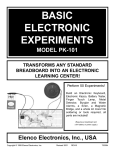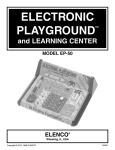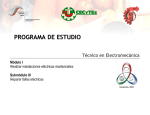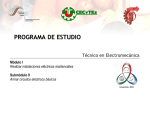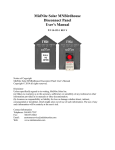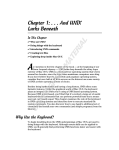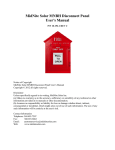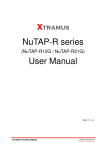Download Elenco Electronics AK-300 Instruction manual
Transcript
ELECTRONIC KEYBOARD MODEL AK-900 ! WARNING: CHOKING HAZARD - Small parts, not for children under 3 years of age. Assembly and Instruction Manual Elenco Electronics, Inc. Copyright © 1997 Elenco Electronics, Inc. Revised 2001 REV-A 753034 PARTS LIST (WE SUPPLY) Bag # main main main 1 1 1 1 2 2 2 3 3 3 3 3 Qty 1 1 1 2 1 2 1 3 2 1 3 3 2 9 15 4 4 4 4 4 4 4 4 5 5 5 5 5 3 3 4 4 2 8 8 4 1 1 1 1 1 Description Circuit Board, fully assembled Top Case Bottom Case Button Cushions with 12 contacts Button Cushion with 2 contacts Piano Cushions with 12 contacts Piano Cushion with 13 contacts Black Piano Key Clips White Piano Key Clips with 7 keys White Piano Key Clip with 8 keys Switch Springs Switch Ball Bearings Speaker Clamps Screws 0.4” x 0.1” (10mm x 2.5mm) for Circuit Board Screws 0.3” x 0.1” or 0.2”x0.1” (7.5mm x 2.5mm or 6mm x 2.5mm) for Bottom Case, Circuit Board side, and Speaker Clamps Switches (black plastic piece with metal contact) Switch Covers (gray plastic piece) Large Pink Buttons Large Pink Button Contacts Small Pink Buttons Small Orange Buttons Small Green Buttons Medium Blue Buttons Speaker, with plug-in connector to Circuit Board Battery Cover Battery Pad AK-900 Label Battery Wires, with plug-in connector to Circuit Board, short wire to battery contact spring, and long wire to battery contact clip TOOLS NEEDED Screwdriver (Phillips type, small-medium size) 6 AA batteries (alkaline are preferred) Tape (Scotch type will be fine) Vaseline or grease -1- Part # 517031 623113 623203 662200 662201 662202 662203 626060 626061 626062 680021 666004 680022 642103 642104 549101 549102 626063 662204 626065 626066 626067 626064 520820 626016 626017 727000 880012 PARTS IDENTIFICATION Button Cushion w/ 12 Contacts Piano Cushion w/ 12 Contacts BAG 1 Piano Cushion w/ 13 Contacts Button Cushion w/ 2 Contacts White Piano Key Clip w/ 7 Keys Black Piano Key Clip BAG 2 White Piano Key Clip w/ 8 Keys Switch Spring Switch Ball Bearing Speaker Clamp Screws Smaller than shown Smaller than shown Smaller than shown 0.4” x 0.1” (10mm x 2.5mm) for Circuit Board BAG 3 0.3” x 0.1” or 0.2” x 0.1” (10mm x 2.5mm or 6mm x 2.5mm) for Bottom Case, Circuit Board Side, and Speaker Clamps Large Pink Button Switch Cover Large Pink Button Contact Medium Blue Button Battery Cover Battery Wires w/ Plug-in Connector to Circuit Board Battery Pad -2- Label BAG 5 Speaker w/ Plug-in Connector to Circuit Board Small Button (Pink, Orange, Green) BAG 4 Switch w/ Metal Contact INTRODUCTION The AK-900 Electronic Keyboard is a electronic music system that you put together. It has 37 keys, 8 instrument sounds (piano, flute, violin, organ, French horn, banjo, music box, guitar), 8 tempo adjustable rhythms (pop music, disco, march, rhumba, tango, waltz, swing, ballad), 4 percussion effects (bass drum, close cymbals, open cymbals, indian snare drum), and 1 demonstration routine along with stereo, vibrato, and tempo effects. Most of these sounds may be combined. The user can add his/her own music to a background tune. It uses 6 “AA” batteries (not included) or an optional AC/DC adapter. The Keyboard is mechanically assembled by the user with no soldering required. The only tool needed is a phillips screwdriver. Recommended for ages 10 and up. However, after the assembly and lesson are completed it will be suitable for ages 3 and up. WARNING: Choking Hazard: This kit contains small parts and should be kept out of the reach of small children until it has been fully assembled. The optional AC/DC Adapter should always be kept away from small children. THEORY OF OPERATION What is Sound? Sound is a variation in air pressure created by a mechanical vibration. (For a demonstration of this, lay one of your stereo speakers on the floor, place your hand on it, and turn up the volume. You should feel the speaker vibrate. Now place a piece of paper on the speaker; if the volume is loud enough, you will see the paper vibrate). Since the vibrations usually last for some amount of time we call the result sound waves. If the vibration occurs at a certain rate, then the sound wave will repeat itself at the same rate; we refer to this as the frequency of the sound wave. Nearly all sound waves have their energy spread unevenly across a range of frequencies. You can compare sound waves from your voice to waves in a pond. When you speak, the movements in your mouth create sound waves just as tossing a rock into the pond creates water waves. Sound waves travel through air as water waves travel across the pond. If someone is nearby, then their ears will feel the pressure variations caused by your sound waves just as a small boat at the other side of the pond will feel the water waves. When you say a word, you create a sound wave with energy at various frequencies, just as tossing a handful of various-sized rocks into the pond will create a complicated water wave pattern. Just as there are sound waves caused by mechanical vibrations, there are also electrical waves caused by electrical variations. Just as sound waves travel through air, electrical waves travel through wires. A microphone senses pressure variations from sound waves and creates electrical waves at the same frequencies. A speaker uses the energy in electrical waves to create mechanical vibrations (sound waves) at the same frequencies. In addition, electrical variations at high frequencies (referred to as radio frequencies) can be used to create electromagnetic radio waves which travel through air and are used for many forms of communication. The subject of music is one where the worlds of art and science come together. Unfortunately, the artistic/musician field works with qualities that depend on our feelings and so are difficult to express using numbers while science/engineering works with the opposite - clearly defined, measurable qualities. As a result, some of the terms used may seem confusing at first, but you will get used to them. Let’s talk about frequency some more. Frequency is the number of repetitions per second (for sound or electrical waves), expressed in units called hertz (Hz). The metric prefixes can be used, so 1000 repetitions per second is 1 kilohertz (kHz) and 1,000,000 repetitions per second is 1 megahertz (MHz). The range of frequencies that can be heard by the human ear is approximately 16 to 16,000 Hz and is referred to as the audio range. The musical world’s equivalent to frequency is pitch. The higher the frequency, the higher the pitch of the sound. Frequencies above 3000 Hz can be considered to provide treble tone. Frequencies about 300 Hz and below provide bass tone. Loudness (the musical term) or amplitude (the electronics term) is increased by simply sending more electrical power to the speaker. -3- Fundamentals of Music What is Music? Music is when vibrations (creating sound waves) occur in an orderly and controlled manner forming a pattern with their energy concentrated at specific frequencies, usually pleasant to listen to. Noise is when the vibrations occur in an irregular manner with their energy spread across a wide range of frequencies, usually annoying to hear (static on a radio is a good example). Notice how some people refer to music that they don’t like as noise. Another way to think of this is that the ear tries to estimate the next sounds it will hear. Music with a beat, a rhythm, and familiar instruments can be thought of as very predictable, hence we find it pleasant to listen to. Notice also that we always prefer familiar songs to music that we are hearing for the first time. Sudden, loud, unpredictable sounds (such as gunfire, a glass breaking, or an alarm clock) are very unnerving and unpleasant. Most electronic speech processing systems being developed use some form of speech prediction filters. Take a piece of string or rope roughly 4 feet long and tie one end of it to a chair or other piece of furniture. Swing the other end up and down so that you have a cyclic pattern, as shown: Now swing it three times as fast (three times the frequency), to produce this pattern: Now try to swing it five times as fast (five times the frequency), to produce this pattern: Since the later patterns are frequency multiples of the first, we refer to them as overtones (the music term) or harmonics (the electronics term) and the original pattern is called the fundamental. If you could combine all three of the above patterns onto the string then you would get a pattern which looks like this: This combined pattern (a single fundamental with overtones) is called a tone (and a pure tone is a single fundamental with no overtones). Notice that each pattern is more difficult to produce than the one before it, with the combined pattern being quite complicated. And also notice that the more complicated patterns are much more interesting and pleasing to look at than the simpler ones. Well the same thing applies to sound waves. Complex patterns that have many overtones for each fundamental are more pleasant to listen to than simple patterns. -4- All traditional music instruments use this principle, with the instrument shapes and materials perfected through the years to produce many overtones for each fundamental chord or key that is played by the user. Grand pianos sound better than upright pianos since their larger shape enables them to produce more overtones, especially at lower frequencies. Concert halls sound better than small rooms because they are designed for best overtone performance and to take advantage of the fact that sound waves can reflect off walls to produce different overtone relationships between both of your ears. The same thing applies to stereo sound. You may have heard the term acoustics, this is the science of designing rooms for best sound effects. The most widely used musical scale (which measures pitch) will now be introduced; for more information please refer to the references. This scale is called the equal temperament scale, expressed in hertz. You might think of this as a conversion table between the artistic and scientific worlds since it expresses pitch in terms of frequency. Each overtone (overtone 0 being the fundamental) is divided into 12 semitones: C, C# (“C-flat”), D, D#, E, F, F#, G, G#, A, A#, and B. The semitones increase by the ratio 12√2, or 1.05946. Musical notes (tones) are the measure of pitch and are expressed using both the semitone and the overtone, such as A3, G#4, D6, A#1, and E2. Your AK-900 Electronic Keyboard plays notes from C3 to C6, in order across the keyboard. (frequency in hertz and rounded off) Up to now, the musical measures of pitch and loudness have been discussed. But many musical sounds have overC C# D D# E F F# G G# A A# B tone 0 16.4 17.3 18.4 19.4 20.6 21.8 23.1 24.5 26.0 27.5 29.1 30.9 1 32.7 34.6 36.7 38.9 41.2 45.7 46.2 49.0 51.9 55.0 58.3 61.7 2 65.4 69.3 73.4 77.8 82.4 87.3 92.5 98.0 104 110 117 123 3 130 139 147 156 165 175 185 196 208 220 233 247 4 262 27 294 311 330 349 370 392 415 440 466 494 5 523 554 587 622 659 698 740 784 831 880 932 988 6 1047 1109 174 1245 1319 1397 1480 1568 1661 1760 1865 1976 7 2093 2217 2344 2489 2637 2794 2960 3136 3322 3520 3729 3951 8 4186 435 4698 4978 5274 5588 5920 6271 6645 7040 7459 7902 9 8372 8870 9397 9956 10548 11175 11840 12542 13290 14080 14917 15804 the same pitch and loudness and yet sound very different. For example, the sound of a guitar compared to that of a piano for the same musical note. The difference is a quality known as timbre. Timbre describes how a sound is perceived, its roughness. Scientifically it is due to differences in the levels of the various overtones, and so cannot be expressed using a single number. -5- Now consider the following two tones, which differ slightly in frequency: If they are played at the same time then their sound waves would be added together to produce: Notice that the combined wave has a regular pattern of where the two tones add together and where they cancel each other out. This is the effect that produces the beat you hear in music. Two tones (that are close in frequency and have similar amplitude for their fundamental and for each of their overtones) will beat at the rate of their frequency difference. Rhythm is the pattern of regular beat that a song has. -6- Now observe this tone: The frequency is slowly increasing and decreasing in a regular pattern. This is an example of vibrato. If the frequency is changing slowly then it will sound like a varying pitch; a fast vibrato (several times a second) produces an interesting sound effect. Tempo is a musical term which simply describes how quickly a song is played. The Electronic Keyboard Implementation: The AK-900 electronically creates sounds that closely resemble those from traditional musical instruments. A quick look at the schematic (a graphical representation of an electronic circuit) on page 17 will show the reader that the IC 9037 is the heart of the product. This part is a 68-pin silicon Large-Scale Integrated Circuit made with CMOS (Complementary Metal-Oxide-Semiconductor) technology. For more information about CMOS and integrated circuits please refer to the references. Please refer to the schematic and the IC 9037 block diagram and pin description on page 17 to help understand the following: The IC 9037 is specifically designed for electronic keyboard applications. It generates a 523.252 kHz signal which is used as a master timing reference for all operations. The 37 keyboard keys represent musical notes C3 to C6 in the musical scale table shown earlier. These are connected directly to the IC 9037 and may be played anytime. These tones are produced by dividing the 523.252 kHz reference down to the appropriate frequency and then adjusting the levels of the overtones based on which instrument is being played. When you play a note on an instrument the sound produced is initially rather loud and then decreases with time. This effect is simulated in the envelope block in the IC 9037 and the resulting output tone also decreases with time. As can be seen from the block diagram, there are two sets of the circuits just described to allow two notes to be played at the same time; once additional notes are played the earlier notes will be discontinued. Since the two most recent notes will be the loudest, this simplification from traditional instruments (such as a piano where the strings continue to vibrate until played again) will not be easily noticed by the listener. More complex electronic instruments will have more circuitry to simulate more notes at the same time as well as more advanced techniques for producing overtones. -7- All of the button selections are handled using ten control lines in a matrix. A matrix is similar to the rows and columns of a table. The matrix is as follows: Column 0 pin 66 Row 0 pin 7 Row 1 pin 6 Row 2 pin 5 Row 3 pin 4 Row 4 pin 3 Column 1 pin 67 Column 2 pin 68 Column 3 pin 1 Column 4 pin 2 Pop rhythm Swing rhythm Piano timbre Horn timbre Cow-Bell sound Disco rhythm Tango rhythm Flute timbre Banjo timbre High-Hat sound March rhythm Ballad rhythm Violin timbre Music-Box timbre Bass-Drum sound Rhumba rhythm Waltz rhythm Organ timbre Guitar timbre Snare-Drum sound Tempo up Tempo down Rhythm start Rhythm stop Vibrato ON/OFF On power-up, the rhythm is stopped, rhythm selection is set to Pop, timbre selection is set to Piano, Tempo is set to medium, and Vibrato is OFF. Percussion (drum-like) sounds are created by playing a short pattern stored in the IC 9037’s electronic memory. All four percussion sounds may be played at the same time. If the demo or one of the rhythms is selected then a much longer pattern is played from the part’s memory in a similar manner. This will include both the tone and percussion circuitry just described and will be repeated until the user presses the stop button. The tempo is adjusted by changing the rate at which this tone pattern is played from memory (by dividing the 523.252 kHz timing reference differently). The vibrato effect is created by varying the divide ratio to the tone circuitry slightly, which will vary the tone frequency and hence the pitch of the sound. The outputs from the two tone circuits and the percussion circuits are combined. The two volume control switches adjust the strength of the tone and percussion signals before combination; weaker electrical signals will resulting in weaker sound waves from the speaker. The combined result is smoothed (to remove unwanted higher frequency signals that were created along with the desired tone and percussion signals), increased in strength (amplified), and applied to the speaker where it is converted from electrical waves to sound waves. If you are unfamiliar with printed circuit boards (PC boards) then observe the advantages that the AK-900 board provides. Notice all of the long, thin copper traces on the board; these are equivalent to having wires connecting all of those points but is much easier to manufacture, much smaller, more reliable, easier to inspect for mistakes, looks nicer, and costs much less. This board has only a single layer of copper traces; circuit board technology has progressed to where boards with 6 layers of traces are not unusual. The board also provides stable mounting for all of the other components. Solder is used to connect the copper traces to the components mounted on the board; it is metal that melts at temperatures typically between 400°F and 800°F. Electronics manufacturers have refined their soldering processes into a fine art through the years. Observe that IC 9037 is the only component in the AK-900 mounted directly on the printed circuit side of the board with no holes through the board; this is called surface-mounting and today many electronics products have ALL of their components surface-mounted due to its advantages in saving space (this was not a concern on the AK-900 due to the space required for the keys and buttons). -8- ASSEMBLY INSTRUCTIONS 1. Take a look at each of the parts bags and compare to the Parts List. Be sure that nothing was damaged during shipping and handling. Contact Elenco Electronics if you have any problems. DO NOT contact your place of purchase as they will not be able to help you. 2. Lay the Circuit Board in front of you, circuit side (green side) up. Locate the Button Cushions and Piano Cushions from Bag #1. Place them onto the Circuit Board one at a time in the arrangement shown in Figure A. The pegs on the Cushions fit into the holes in the Circuit Board but will be loose; flip the Board over to the components side and pull on each of the pegs (be careful not to bend the red LEDs on the circuit side while doing so), see Figure B. The Cushions should now be flush on the Circuit Board. Button Cushion w/ 12 Contacts Green Side of the PC Board Piano Cushion w/ 13 Contacts Button Cushion w/ 2 Contacts Piano Cushion w/ 12 Contacts LEDs Component Side of the PC Board Piano Cushion w/ 12 Contacts Pegs Figure A Figure B 3. Lay the Top Case upside-down in front of you. Locate the Switches (Bag #4), Switch Covers (Bag #4), Switch Springs (Bag #3), and Switch Ball Bearings (Bag #3). Make sure the metal contacts are bent up 45O (otherwise they may not contact the circuit board), and that they are not damaged. Place a Spring into the hole in the side of one of the Switches (as shown in Figure C). Place some Vaseline or grease into the ball grooves in the switch slots on the inside of the Top Case (to ensure the Switch will switch smoothly) and a drop on the Switch Spring. Place a Ball Bearing onto the Spring (the Vaseline helps hold the Bearing in place) and carefully place the Switch into one of the switch slots, being sure not to drop the Bearing while doing so. Next, press a Switch Cover into the Switch from the outside of the Top Case while holding the Switch in place on the inside of the Case (as shown in Figure D). Be sure the Switch moves properly between each of the switch settings and then install the other two Switches in the same manner. Switch Covers Spring Switch Ball Bearing Switches Figure C Figure D -9- 4. Locate the Black and White Piano Key Clips (Bag #2). Place the White Clips into the inside of the Top Case (as shown in Figure Ea). There are 3 small pegs (one for each clip) on the inside for alignment. The tab at the end of each key must slide into its slot on the front of the Case (the “bottom of the keyboard”) so that it will not be visible (as shown in Figure Ea). The White Clip with 8 keys (the others have 7) will have to be placed so that its “extra” key is the most distant key from the speaker slot. Next, lay the Black Clips onto the White Clips from the inside, using the alignment pegs again (as shown in Figure Eb). White Piano Key Clip w/ 7 Keys Figure Ea Alignment Pegs Top Case White Piano Key Clip w/ 8 Keys White Piano Key Clip in Case Slots Black Piano Key Clips Alignment Peg Figure Eb -10- 5. Locate the buttons (Bag #4). Attach the 4 Large Pink Button Contacts to the Large Pink Buttons as shown in Figure F. Now place the 4 Large Pink Buttons, the 8 Small Green Buttons, the 8 Small Orange Buttons, the 4 Medium Blue Buttons, and the 2 Small Pink Buttons into the inside of the Top Case as shown in Figure F. Carefully lift up the Top Case without tipping it (so that the buttons don’t fall out) and compare it to the picture on the box for your Electronic Keyboard. It should match, except for 2 small holes for the red LEDs which will be added with the Circuit Board. Correct your buttons arrangement now if necessary. Small Pink Buttons Small Orange Buttons Medium Blue Button Small Green Button Large Pink Button Contact Large Pink Button Figure F Green Green Green Green Orange Orange Orange Orange Green Green Green Green Orange Orange Orange Orange Blue Blue Blue -11- Blue Pink Pink 6. Straighten the red LEDs (Light-Emitting-Diodes) on the Circuit Board so that they are standing straight up (they may have been bent to protect them during shipping). Place the Circuit Board into the Top Case, components side facing you, as shown (it is aligned using 8 tabs on one side and 2 tall screw holes on the other side). Make sure the red LEDs are still straight and will be visible from the outside and that you don’t knock any of the buttons out of position. It is a good idea to elevate the unit enough so that it isn’t resting on any of the buttons (otherwise, some buttons might be knocked out of position and won’t work properly). Secure with 3 small side Screws (0.2” x 0.1” or 0.3” x 0.1”, from Bag #3) and then 9 large Screws (0.4” x 0.1”, also Bag #3) as shown. Note that not all of the screw holes are used. Now flip the Top Case over and again compare it to the picture of it on the box. It should look the same. Press each of the buttons to be sure they depress properly. If not, unscrew the Circuit Board and check the arrangement of your buttons. Small Side Screws LED Figure G Green Side of the PC board Large Screw Component Side of the PC board Tab CAUTION: IMPORTANT Make sure that the PC board goes under the tabs on the case as shown. -12- Component Side of the PC board 7. Place the Speaker (Bag #5) in its slot next to the Circuit Board and plug its connector into the Circuit Board. The tab on the speaker connector should be facing the Speaker so that the connectors “lock” together. If the tab is on the wrong side then the Speaker will be wired incorrectly and will not work. Speaker Figure H Connector Connector 8. Place the Speaker Clamps (Bag #3) as shown in Figure I to hold the Speaker in place and secure with two Screws (0.2” x 0.1” or 0.3” x 0.1”, also Bag #3). Small Screws Speaker Clamps Figure I -13- 9. Connect the Battery Wires (Bag #5) to the Circuit Board by plugging in the connector (as shown in Figure J). The tabs on the connector should be facing the Speaker so that the connectors “lock” together. If the tabs are on the wrong side then the product will be wired incorrectly and will not work. Now place the Bottom Case alongside the Top Case. Spread the Battery Wires into the Bottom Case (using the small pegs as a guide for the long wire) and press the battery contact spring and battery contact clip into position without breaking the wires, as shown. The clip will be a snug fit and you may need to tap it with a screwdriver to get it in all the way. Hold the long wire into position using several pieces of tape. Bottom Case Battery Contact Spring Connector Scotch Tape Battery Contact Clip Figure J 10. Place Bottom Case onto Top Case (upside down) and secure with ten Screws (0.3” x 0.1” or 0.2” x 0.1”, Bag #3), as shown in Figure K. Small Screw Figure K -14- 11. Make sure the Power switch is OFF. Insert 6 AA batteries into the back of the unit being sure to orient their positive and negative terminals properly, as shown in Figure L (if you intend to use the optional AC/DC Adapter then you don’t need batteries). Remove the backing from the Battery Pad and stick it on the Battery Cover, then place the Cover in its slot on the Bottom Case to secure the batteries. Place the AK-900 Label in the center of the Bottom Case. Label AA Battery Figure L OPERATING INSTRUCTIONS Turn the unit on and adjust the speaker volume as needed (you may adjust the rhythm and master volumes separately). You may use the keyboard and custom drummer (the big pink buttons) by themselves or combined with background music. The orange buttons provide background dance music; press one of them and then the start button. The blue DEMO button plays the demonstration tune “Greensleeves”; to stop the demo, press the DEMO button again. The green buttons select which instrument the keyboard is simulating (piano, flute, violin, organ, french horn, banjo, music box, guitar). Use the small pink buttons to change the tempo of the demo or the dance music. The Vibrato button turns the vibrato effect ON/OFF. This product operates with six AA batteries. The unit will not sound as usual if the batteries are weak, in this case try changing the batteries. For longer battery life take out the batteries if the unit will not be used for a long time and use alkaline batteries. You may also operate this product with an AC/DC Adapter that has a 9V output voltage and 400mA current rating. This may be purchased through Elenco Electronics or at your local electronics store. WARNING FOR USE OF AC/DC ADAPTER: The Adapter should be regularly examined for potential hazards of damaged cable, plug, and enclosure. In the event of such damage the adapter must not be used until such damage has been properly removed. The Adapter must comply with CEE publication -15. -15- TROUBLESHOOTING GUIDE Symptom: Keyboard doesn’t work at all. • Make sure that the batteries are new and that they are installed with the correct polarity. If using the optional AC/DC Adapter then make sure it is undamaged and plugged in. • Make sure the ON/OFF switch is ON. Make sure the volume controls are not at the lowest setting. • If the red LED next to the ON/OFF switch is off then flip the ON/OFF switch several times, pressing it hard. • Be sure that none of the wiring connections were broken, are contacting any other metal (creating a “short circuit”), or are wired wrong. • Be sure that there is no physical damage to the Main PCB. Symptom: Sounds don’t sound normal, as if out-of-tune. • Make sure that the batteries are new and that they are all installed with the correct polarity. Alkaline or carbon zinc batteries are preferred. Symptom: Some of the keys, buttons, or switches do not work. • Be sure all the keys, buttons, and switches are properly situated as in assembly steps 2-5. • Examine the Cushions on the Circuit Board, make sure they are laying flat on the Board and that they are not damaged. • Be sure there is no physical damage to the components or copper traces on the Circuit Board. Note: Contact Elenco Electronics, Inc. at (847) 541-3800 or e-mail us at [email protected] if you need further assistance. DO NOT contact your place of purchase as they will not be able to help you. QUIZ 1. Sound waves travel through air just as electrical waves travel through __________. 2. A microphone converts sound waves into __________ __________. 3. Pitch is the musician’s term for __________. 4. Mechanical variations in a loud and unpredictable manner will seem more like noise than __________ to a listener. 5. Traditional music instruments produce many __________ for each fundamental. 6. Musical note G5 has a frequency of __________ Hz (refer to the musical scale). 7. The main properties of a musical sound are loudness, pitch, and __________. 8. Two tones, with frequencies of 250 Hz and 255 Hz and similar loudness, will produce a __________ when played together. 9. ________ is adjusted in the AK-900 by changing the rate at which a tone pattern is played from memory. 10. Long, thin copper traces connect electronic components on __________ __________ __________. Answers: 1. wires; 2. electrical waves; 3. frequency; 4. music; 5. overtones; 6. 784; 7. timbre; 8. beat; 9. tempo; 10. printed circuit boards. -16- SCHEMATIC DIAGRAM IC 9037 BLOCK DIAGRAM VIBRATO OSC1 OSC2 Oscillator KEY1 KEY2 KEY36 KEY37 R0 R1 R2 R3 R4 Direct Keyboard Logic Matrix Control Key Logic VDD Timing Divider Driver OUT1 Tone1 Generator Envelope Circuit ENV1 Tone2 Generator Envelope Circuit Rhythm Generator Driver Percussion Generator D/A Output Tempo Circuit CO C2 C4 C1 C3 TEMLED -17- Melody Control & PLA VSS DEMO ENV2 OUT2 BD SD HH CB IC 9037 Pin Description Pin No. Pin Name I/O Internal Connection 1, 2 C3, C4 0 NMOS 3-7 R4 - R0 I CMOS Pull-High Matrix control key scanning inputs Direct key inputs There are 22 full-scale and chromatic-key inputs for playing. Description Matrix control key scanning outputs 8 - 44 KEY1 - KEY37 I CMOS Pull-High 45 VSS I - 46 DEMO I CMOS Pull-High 47 OUT1 O Transmission Gate 48 ENV1 O CMOS 49 OUT2 O Transmission Gate 50 ENV2 O CMOS Channel 2 envelope effect pin 51, 52 TEST1, TEST2 I/O CMOS For IC test only 53 TEMLED O NMOS Open Drain Tempo indication output 54 VDD I - Power supply (positive) 55 VIBRATO O CMOS 56 RESET I CMOS Pull-High 57 TEST3 I/O CMOS For IC test only 58 OSC1 I - Oscillator input Oscillator output The scale is from C3 to C6. Power supply (ground) ON/OFF demo song control input The title of the demo song is “Green Sleeve”. Channel 1 tone output Channel 1 envelope effect pin Channel 2 tone output Vibrato signal output Power-on reset pin 59 OSC2 O - 60, 61 TEST4, TEST5 I CMOS 62 CB O - Cow-Bell pulsatile signal output 63 BD O - Bass-Drum pulsatile signal output 64 SD O - Snare-Drum pulsatile signal output 65 HH O - High-Hat pulsatile signal output 66 - 68 C0 - C2 O NMOS For IC test only Matrix control key scanning outputs -18- GLOSSARY OF TERMS Acoustics The science of designing rooms for best sound effects. Amplitude A measure of the strength of an electronic signal. Audio The range of sounds that can be heard by the ear. Bass Tones Low frequency sound, usually below 300 Hz. Beat A pattern in musical rhythm caused by 2 tones at different frequencies (usually close), so that they regularly form highs and lows in loudness. Equal Temperament Scale A musical scale for measuring pitch. Electrical Waves Electrical energy similar to sound waves but caused by electrical vibrations and traveling through wires. Electromagnetic Radio Waves Electromagnetic energy similar to electrical waves but caused by electrical vibrations at higher frequencies and traveling through air; used for many forms of communications. Frequency The rate at which a pattern or wave repeats itself. Fundamental The lowest (and usually the loudest) frequency in a tone. Harmonics The electronics term for frequencies that are exact multiples of a lower frequency (the fundamental) produced by the same source. Hertz (Hz) The number of repetitions per second. Integrated Circuit An electronic circuit that has been made very, very small. Kilohertz (kHz) The number of repetitions per second, expressed in thousands. Light-Emitting-Diodes (LEDs) A device which converts electrical energy into light. Loudness A measure of the strength of sound waves, also called volume. Megahertz (MHz) The number of repetitions per second, expressed in millions. Metric System An international system of measurement. Microphone A device which converts sound waves into electrical waves. Musical Note A measure of the pitch of a sound, expressed using semitones and overtones in a musical scale. Noise Mechanical vibrations (sound waves) occurring in an irregular manner with their energy spread across a wide range of frequencies, usually annoying to hear. Overtones The musical term for frequencies that are exact multiples of a lower frequency (the fundamental) produced by the same source. Percussion Sounds Drum-like, hitting one thing against another. Pitch The musical world’s term for frequency, expressed using a musical scale; may be perceived differently between people. Printed Circuit Board A board for mounting electronics components that has copper traces “printed” on the surface for connecting the components instead of using wires. Pure Tone A fundamental frequency with no overtones. -19- Rhythm The pattern of regular beat that a song has. Schematic A graphical representation of an electronic circuit. Semitones The division of notes within each overtone on the musical scale. Solder A metal that melts at temperatures between 400°F and 800°F; it is used to connect electronic components to each other or to copper traces on printed circuit boards. Sound A variation in air pressure caused by a mechanical vibration; our ears can usually feel this. Sound Waves Air pressure waves caused by mechanical vibrations. Speaker A device which converts electrical waves into sound waves. Tempo A musical term which describes how quickly a song is played. Timbre The quality of sound that separates tones equal in pitch and loudness but perceived differently, it is due to differences in the levels of the various overtones. Tone A sound with a fundamental and overtones. Treble Tones High frequency sound, usually above 3000 Hz. Vibrato When the frequency of a tone is slowing increasing and decreasing at a regular rate. FOR FURTHER READING (These are available through Elenco Electronics Inc., unless stated otherwise). Evans A. (1992). Making Sense of Sound. Sams (61026) Sundberg J. (1991). The Science of Musical Sounds. Electronics, try your local bookstore or library. Academic Press. Not available through Elenco Pierce J. R. (1983). The Science of Musical Sound. Scientific American Books. Not available through Elenco Electronics, try your local bookstore or library. Douglas A. (1976). The Electronic Musical Instrument Manual. Tab Books (#832). Not available through Elenco Electronics, try your local bookstore or library. Penfold R. A. (1995). Music Projects. Sams (67052) Rezurch I. (1996). Electronics Terminology. Sams (67013) Mileaf H. (1978). Electricity 1-7. Sams (159523) Johnson J. R. (1994). Schematic Diagrams. Sams (61059) Kamichik S. (1996). Digital Electronics. Sams (61075) -20- Here are some other exciting projects from Elenco you can build. SOLDERLESS KITS Talking Clock Kit 35mm Camera Kit with training course with training course Model AK-220 Model AK-540 This easy-to-build kit will teach you how electronic voices are made. Model AK-220 uses analog hands to display time and has hourly reports. Wake up to a rooster crowing in the morning. Now you can learn all about photography with our new Camera Kit. Our training manual will teach you everything you need to know about light, film, speed, exposure, development, and much more. And best of all, you’ll have a working camera “you built” when you’re finished. RADIO CONTROLLED CAR KIT The Turbo King is our newest solderless kit. R/C cars are the hottest thing going, and you can build your own from the ground up. You’ll learn all about gears, motors, RF frequency and more from our detailed assembly and training manual. Before you know it, you’ll be ready to race! 7 Radio Functions. Flashing Top Light. Single Channel. Model AK-870 -21- All kits on this page require soldering. DELUXE KITS Stereo Cassette Kit Digital Roulette Kit with training course with training course Model AK-200 Model AK-300 Easy-to-build kit teaches you basic mechanical and electronic circuits. You will have fun building this kit and learning how a tape player works. Lesson manual teaches magnetic recording, audio amplifier theory, speed control, mechanical switching, and much more. Clear plastic case allows you to show your friends your accomplishments. Headphones included. Requires two (2) “AA” batteries. This Digital Roulette Kit is just like the real thing. With a push of a button, the LEDs spin round and round. Where they stop is anybody’s guess. Its unique design includes “pop out” chips of different values. Enjoy hours of fun with this game of chance. Requires one (1) 9V battery. Clear Telephone Kit FM Wireless Microphone Kit with training course Model AK-700 Model AK-710 This is our most popular kit. Our Telephone Kit will teach you all about communications. You will actually build your own phone and be able to make and receive calls. The clear plastic case lets you see all of the working components. It even has flashing neon lamps when the phone rings. Now you can hear your voice on the radio! This kit will have you singing in no time at all. After following our easy assembly manual, you’ll be ready to transmit your voice on an actual FM radio. Range up to 100 feet. Requires two (2) “AA” batteries. -22- Elenco Electronics, Inc. 150 W. Carpenter Avenue Wheeling, IL 60090 (847) 541-3800 http://www.elenco.com e-mail: [email protected]
























